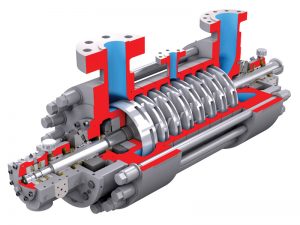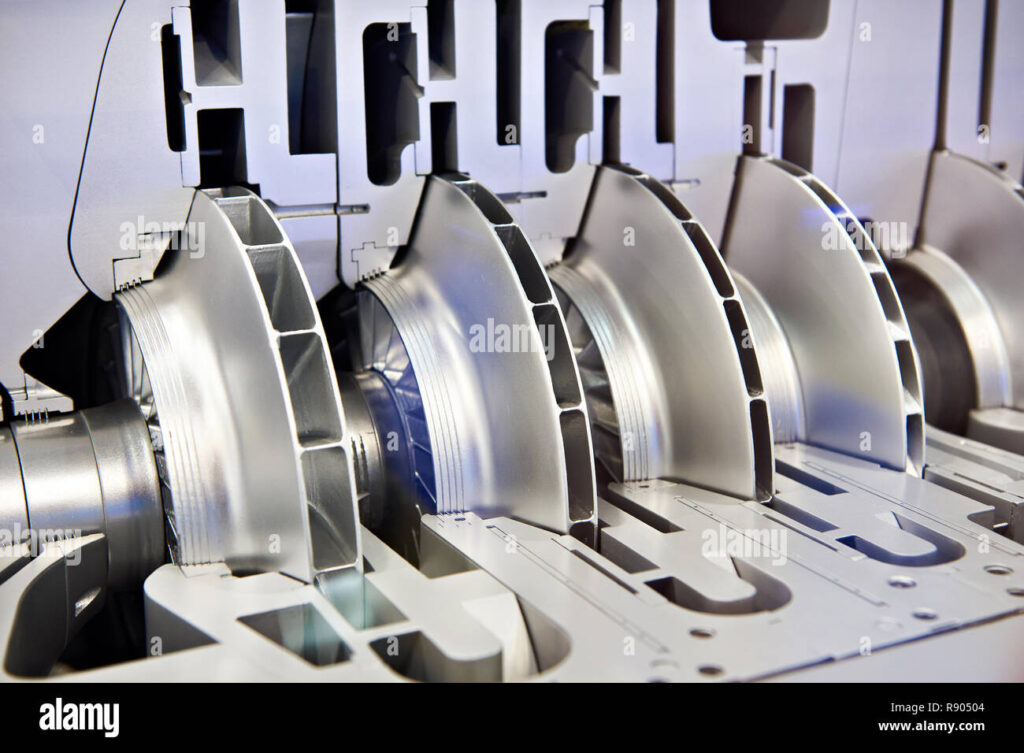MATERIALS BY COMPONENTS IN CENTRIFUGAL COMPRESSORS - TYPICAL

Here are the typical materials used for various components in centrifugal compressors:
| Component | Typical Materials |
|---|---|
| Diaphragms | Stainless steel, nickel-based alloys (e.g., Inconel), or titanium |
| Guide Vanes | Stainless steel or carbon steel |
| Impeller | Carbon steel, stainless steel, duplex stainless steel, or nickel-based alloys |
| Casing | Carbon steel, stainless steel, duplex stainless steel, or nickel-based alloys |
| Rotor Shaft | Alloy steel, stainless steel, or nickel-based alloys |
| Rotor Blades | Nickel-based alloys (e.g., Inconel) |
| Labyrinth Seals | Carbon or stainless steel |
| Balance Piston | Carbon steel or stainless steel |
| Shaft Sleeves | Stainless steel, bronze, or nickel-based alloys |
| Interstage Seals | Carbon or stainless steel |
| Dry Gas Seal Components | Stainless steel, nickel-based alloys (e.g., Inconel), or ceramic materials |
Please note that the specific material selection for each component depends on factors such as the process conditions (temperature, pressure, corrosiveness), mechanical requirements, and compatibility with the process fluid.
LIMITATIONS IN ENGINEERING & DESIGN ABOUT COMPONENTS IN CRITICAL SERVICES (SOUR, ACID OR SEVERE SERVICES) IN CENTRIFUGAL COMPRESSORS
Some of the key limitations and design considerations include:
Corrosion Resistance: Internal components must be resistant to corrosion and degradation caused by the process fluids. Materials selection should consider the corrosive nature of the fluid, including its acidity, presence of corrosive gases (such as H2S), and other contaminants.
High Temperature and Pressure: Centrifugal compressors often operate under high temperatures and pressures. Materials should be capable of withstanding these conditions without compromising their mechanical properties, including strength and creep resistance.
Compatibility with Process Fluid: The material must be compatible with the specific process fluid to avoid chemical reactions or degradation that could lead to material failure. Compatibility testing or corrosion resistance assessments are typically conducted to evaluate the suitability of materials.
Fatigue and Fracture Resistance: Internal components are subjected to cyclic loading, which can lead to fatigue and potential fracture. Materials with good fatigue resistance and fracture toughness are necessary to ensure the longevity and reliability of the components.
High Strength and Stiffness: Centrifugal compressors require materials with sufficient strength and stiffness to withstand the operating conditions and mechanical stresses encountered during operation.
Weldability and Fabrication: Materials used in centrifugal compressors should possess good weldability and be amenable to fabrication processes such as machining, forging, and welding to allow for the manufacture and assembly of complex components.
Standards and Codes: Compliance with industry standards and codes, such as the API-617 standard, ensures that materials meet the required specifications and have been tested and validated for use in centrifugal compressors.
Given the critical nature of centrifugal compressors in the oil and gas industry, materials selection is a vital aspect of the design process. It involves considering the specific operating conditions, process fluids, and the industry’s best practices to ensure high reliability, safety, and longevity of the equipment.
PROCEDURES, ACTIONS, STUDIES, ANALYSIS, MITIGATIONS, RECOMMENDATIONS TO USE MATERIALS IN CENTRIFUGAL COMPRESSORS APPLICATIONS
Process Conditions Evaluation: Conduct a thorough assessment of the operating conditions, including temperature, pressure, fluid composition, corrosiveness, and presence of contaminants. This evaluation helps identify the specific challenges the materials will face during operation.
Material Selection Criteria: Define the material selection criteria based on the process conditions and requirements. Consider factors such as corrosion resistance, temperature resistance, strength, fatigue resistance, compatibility with process fluids, and weldability.
Materials Testing and Evaluation: Perform materials testing to evaluate the mechanical properties, corrosion resistance, and compatibility of candidate materials with the process fluids. Testing methods may include tensile testing, impact testing, corrosion testing, and stress corrosion cracking testing.
Corrosion and Material Compatibility Assessment: Conduct corrosion studies to assess the compatibility of materials with the process fluids. This includes evaluating corrosion rates, susceptibility to pitting, stress corrosion cracking, and hydrogen embrittlement.
Failure Modes and Effects Analysis (FMEA): Perform FMEA to identify potential failure modes, their effects on compressor performance, and the criticality of these failures. This analysis helps prioritize materials selection and design improvements to mitigate high-risk failure modes.
Finite Element Analysis (FEA): Utilize FEA to evaluate the structural integrity and mechanical performance of critical components under different operating conditions. This analysis aids in identifying potential weaknesses and optimizing the design for improved reliability.
Material Standards and Specifications: Refer to relevant industry standards and specifications, such as API-617, for guidance on material requirements and recommendations. These standards provide guidelines for material selection, manufacturing processes, and quality assurance.
Maintenance and Inspection Planning: Develop a comprehensive maintenance and inspection plan that includes regular inspections of critical components, non-destructive testing (NDT), and preventive maintenance activities. This ensures early detection of potential material degradation or failure and enables timely corrective actions.
Material Traceability and Quality Control: Implement strict material traceability and quality control measures to ensure that materials used in manufacturing meet the required specifications and standards. This includes verifying material certificates, conducting material inspections, and audits of suppliers.
Documentation and Knowledge Management: Maintain accurate documentation of materials used, their properties, and their performance in specific applications. This information serves as a knowledge base for future materials selection and helps identify areas for improvement based on historical data.
It’s important to note that these procedures and actions should be carried out by qualified engineers and professionals with expertise in materials selection, compressor design, and relevant industry standards. Additionally, compliance with applicable regulations and standards specific to your industry is crucial to ensure safety and reliability in centrifugal compressor applications.

